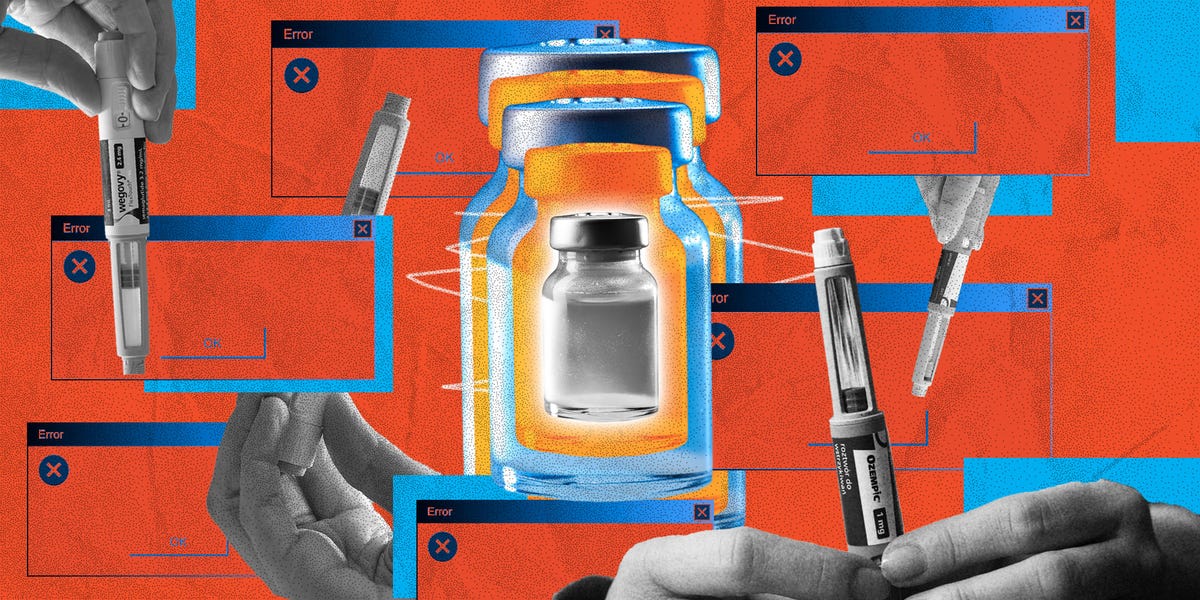A PAIR OF feet step onto a scale. Then another, and another. A jiggly belly flashes onscreen.
“Obesity is America’s deadliest epidemic,” a narrator intones over Childish Gambino’s “This Is America.” “Something’s broken, and it’s not our bodies—it’s the system.”
In front of a Super Bowl television audience of nearly 128 million people, the telehealth company Hims & Hers Health was pitching itself as an answer to this broken system. “Hims & Hers offers life-changing weight-loss medications. They’re affordable, doctor-trusted, and formulated in the USA.” The narration continues: “You deserve to feel great in your body.”
The slickly produced ad suggests that rather than profiting from the weight-loss industry, Hims & Hers was taking a stand against it. But the company sells GLP-1 drugs like Ozempic and Wegovy, which according to a 2024 poll, are being used by roughly 6 percent of Americans (that’s an estimated 20 million people). The doublespeak triggered some backlash—not only because the company is, in fact, capitalizing on the $15 billion weight-loss drug market, but because the company also didn’t explicitly mention in the voiceover that it sells the compounded version of these medications (made by combining, mixing, or altering ingredients), which aren’t approved by the FDA.
Today, around 2 million people are sourcing GLP-1s online, thanks to the boom in online providers offering these compounded drugs and the relatively few hoops telehealth patients need to jump through to get them. You’ve probably heard the stories from your buddies: You fill out some personal info, send a couple of messages back and forth with a prescriber, and bam—medication secured, no primary doc visit required.
But the compounded drugs these telemedicine companies have been selling can come with health risks—and research shows that some telehealth sites might be misleading customers. A January 2025 cross-sectional study found that of 79 websites selling compounded medications, nearly half didn’t report known adverse effects (including nausea, vomiting, abdominal pain, fainting, headache, migraine, dehydration, acute pancreatitis, and gallstones) and warnings for compounded GLP-1s. And 13 percent didn’t disclose that the GLP-1s for sale were, in fact, compounded.
Sketchy marketing aside, the entire GLP-1 market is in the thick of a major shakeup. Less than a month after that Super Bowl ad aired, the FDA began announcing new policies that require compounding pharmacies to stop making compounded semaglutide and tirzepatide (the active ingredients in Ozempic and Mounjaro, respectively), which also means—in theory—that telemedicine companies need to stop selling these drugs. This potentially leaves millions of people scrambling to find new sources for their medication if their telehealth company can no longer provide it—and they might have to (quite literally) pay the price for it.
To help you navigate the next phase of the GLP-1 market, we spoke to experts about what to know before signing up for a GLP-1 telemedicine service, how to access these medications going forward, and the scams to be aware of.
The Explosion of Compounded GLP-1s
Before we get into what comes next for the online GLP-1 market, we need to understand how we got here. GLP-1 drugs have been around for more than a decade to help people manage type 2 diabetes, but the ones developed in recent years—Ozempic, Wegovy, Mounjaro, and Zepbound—have exploded in popularity after becoming the worst-kept celebrity weight-loss secret.
The Danish company Novo Nordisk sells several different brand names with semaglutide as an active ingredient: notably, Ozempic, for diabetes and reducing cardiovascular event risks, and Wegovy, for weight loss and reducing cardiovascular event risks. A U.S. drug giant, Eli Lilly, makes two brands of medication with tirzepatide as an active ingredient: Mounjaro for diabetes, and Zepbound for weight loss. These name-brand drugs must meet the FDA’s standards for safety and efficacy before they hit the market and are available only by prescription.
To be prescribed one of these drugs, you need to either a) have type 2 diabetes; b) have a body mass index (BMI) of at least 30; or c) have a BMI between 27 and 30 plus at least one weight-related health condition, such as cardiovascular disease, high blood pressure, or high cholesterol.
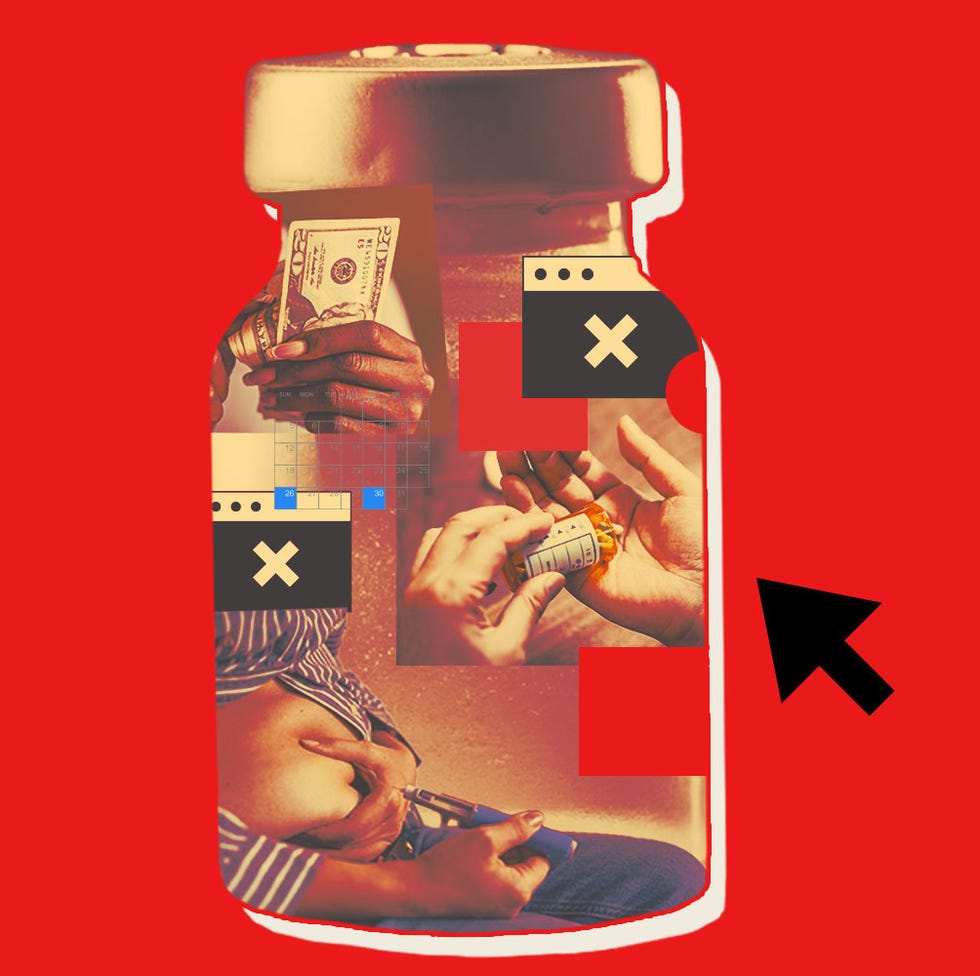
Getty Images. Men’s Health Illustration / Jason Speakman
Because the drugs are so popular, there’s often not enough medication to go around. In 2022, the FDA added both semaglutide and tirzepatide to its drug-shortage list. Under a special rule, this has allowed compounding pharmacies to make their own versions of the drugs for distribution, pumping a steady stream of the compounded medications into the marketplace. These compounded medications have the same active ingredient as the name-brand drugs, but they might include other ingredients like vitamins, so they don’t violate pharma patents.
In turn, new and existing telehealth companies like Hims, Ro, and Noom situated themselves as middlemen, funneling the supply of compounded medications to customers and reaping huge profits. (In 2024, Hims & Hers brought in $1.5 billion in revenue, a 69 percent increase from the previous year.) Practitioners can prescribe the medications to patients remotely, and then the telehealth company ships them to their homes. Depending on the company, the prescriber might speak to a patient directly via video chat (rare) or just write a prescription based on a form that a patient has filled out (more common).
Though insurance doesn’t cover compounded medications, they typically cost a few hundred bucks a month, plus whatever monthly fee is required from the telemedicine service. It’s a much better deal than paying $1,000 per month or more out-of-pocket for name-brand prescriptions that are only sometimes covered by insurance, but, like most good things, those deals come with a pretty big asterisk.
The Risk and Reward of Compounded Drugs
Big picture, this rapid expansion in drug supply has some major upsides. Millions of people have had access to compounded versions of these medications that they might not have been able to afford otherwise. And they’re likely providing important health benefits, like lower blood sugar levels and improved heart health.
At the same time, these compounded medications can come with safety risks. Unlike the name-brand medications sold by big companies, compounded medications—whether the compounding pharmacies they’re made in are registered with the FDA or not—are not subject to pre-market regulation. That means instead of having to meet FDA standards for safety, effectiveness, and quality before they can be sold, compounded drugs can go directly from the lab to your door. Some telehealth companies like Ro and Hims hire third-party companies to test the compounded medications for quality and purity, but not all of them do.
There are two main types of U.S. compounding facilities: 503A compounding pharmacies and 503B outsourcing facilities. The 503A compounding pharmacies are registered with the Drug Enforcement Administration (DEA) and the state they are in. Facilities designated as 503B are held to stricter regulatory standards, since they typically make larger batches for health care systems or use in physicians’ offices. However, not all of them register with the FDA. (You can check the FDA website to see if a company is registered.)
“Instead of having to meet FDA standards for safety, effectiveness, and quality before they can be sold, compounded drugs can go directly from the lab to your door.”
The FDA has made an effort to crack down on unregistered 503B outsourcing facilities and has issued warnings to consumers that compounded medications might be ineffective or harmful to your health. But the sheer number of outsourcing facilities has had the agency playing whack-a-mole.
Gaming out the risks and benefits can be tricky. For someone with a lot of weight to lose and no underlying health problems, Jyotsna Ghosh, MD, an obesity-medicine specialist at Johns Hopkins Medicine, says going with a telehealth company that sources compounded meds from a vetted pharmacy in the 503B category could be a smart choice. But for someone with a smaller percentage of their body weight to lose, or with health conditions, compounded medications might introduce unnecessary risk, she said.
While the half-dozen men who spoke to me for this story largely said they had good experiences with compounded weight-loss drugs, doctors are concerned about the widespread use of compounded medications. They said that compounded medications could contain contaminants, or dosing could vary quite a bit from that of name-brand medications and potentially be less effective. But until recently, going through telehealth companies that sourced drugs from compounding pharmacies might have been the only way somebody could get, and stay, on a GLP-1 medication.
Compounders, Begone
Last fall, the FDA announced that the tirzepatide shortage was over. After pushback from the compounding pharmacies, the agency agreed to reevaluate its decision, but in December 2024, it announced it would be sticking with its original call. Two months later, the FDA said the semaglutide shortage was over too.
503A compounding facilities had to immediately stop producing compounded tirzepatide and semaglutide. 503B facilities had to do the same with compounded tirzepatide, but had until May 22 for compounded semaglutide. That means by now, all compounding pharmacies are technically required to stop making these drugs.
Shortly after the agency dropped the end-of-shortage news, Hims & Hers’ stock price plummeted 25 percent. Over on Reddit, subreddits like “What does the official end of shortage mean for people taking compounded semaglutide?” in r/CompoundedSemaglutide, and “FDA declares end to Wegovy and Ozempic shortage” in r/medicine surfaced, with many people wondering what they’re supposed to do now.
“By now, all compounding pharmacies are technically required to stop making these drugs.”
One of them is Rob Enderle, a 37-year-old in upstate New York, who said that compounded semaglutide has improved his health—and his life—big time. The ginger-bearded, blue-eyed delivery driver said he’s been a heavier guy since childhood. As a kid, he didn’t have a solid understanding of what healthy eating should look like—he’d snack on soda and Snickers bars, and dinner might have been SpaghettiOs or instant mashed potatoes. In high school, he played baseball, but his weight still made him a target for bullies. He earned an associate’s degree in criminal justice and worked for many years as an armed security guard—a job he found stressful, which made it easy to overindulge in his favorite foods from McDonald’s and Taco Bell. Over the years, he tried crash diets, like Atkins or intermittent fasting, and might drop 30 or 40 pounds, only to gain them back within a few months.
After a motorcycle accident last year left him with a broken foot that required surgery, Rob knew he needed to make big, permanent changes part of his overall recovery. I gotta turn things around, he remembered thinking. My eating, my whole life. I’m almost 40, and usually things don’t get better from here.
He spoke to his primary care doctor about Ozempic, but because he didn’t have a health condition like diabetes, his insurance wouldn’t cover the name-brand drug that would have cost him $1,300 per month. So Rob looked online for the more affordable compounded medications, comparing customer reviews from telehealth services like Henry Meds and Hims. Hims had the best reviews, he says, so he filled out an intake form on its site with info including his starting weight (around 350 pounds). He didn’t speak directly with a health care provider. But through the telehealth company’s back end, one wrote him a prescription for compounded semaglutide. He paid about $2,100 upfront for a year of the medication (which included additional fees from the telehealth platform), and a three-month supply shipped to his door within a few days.
Since Rob started the medication about a year ago, he’s dropped around 100 pounds, and his relationship with food has totally transformed. Instead of takeout, he often cooks for himself—usually a lean protein like chicken, with vegetables and rice. Chores like cleaning, and his very physical delivery job, feel much easier. “It’s like being free from a prison,” he says. Now that telehealth companies can no longer sell the cheaper compounded medication, it’s unclear whether or not he’ll be able to afford to stay on a GLP-1.
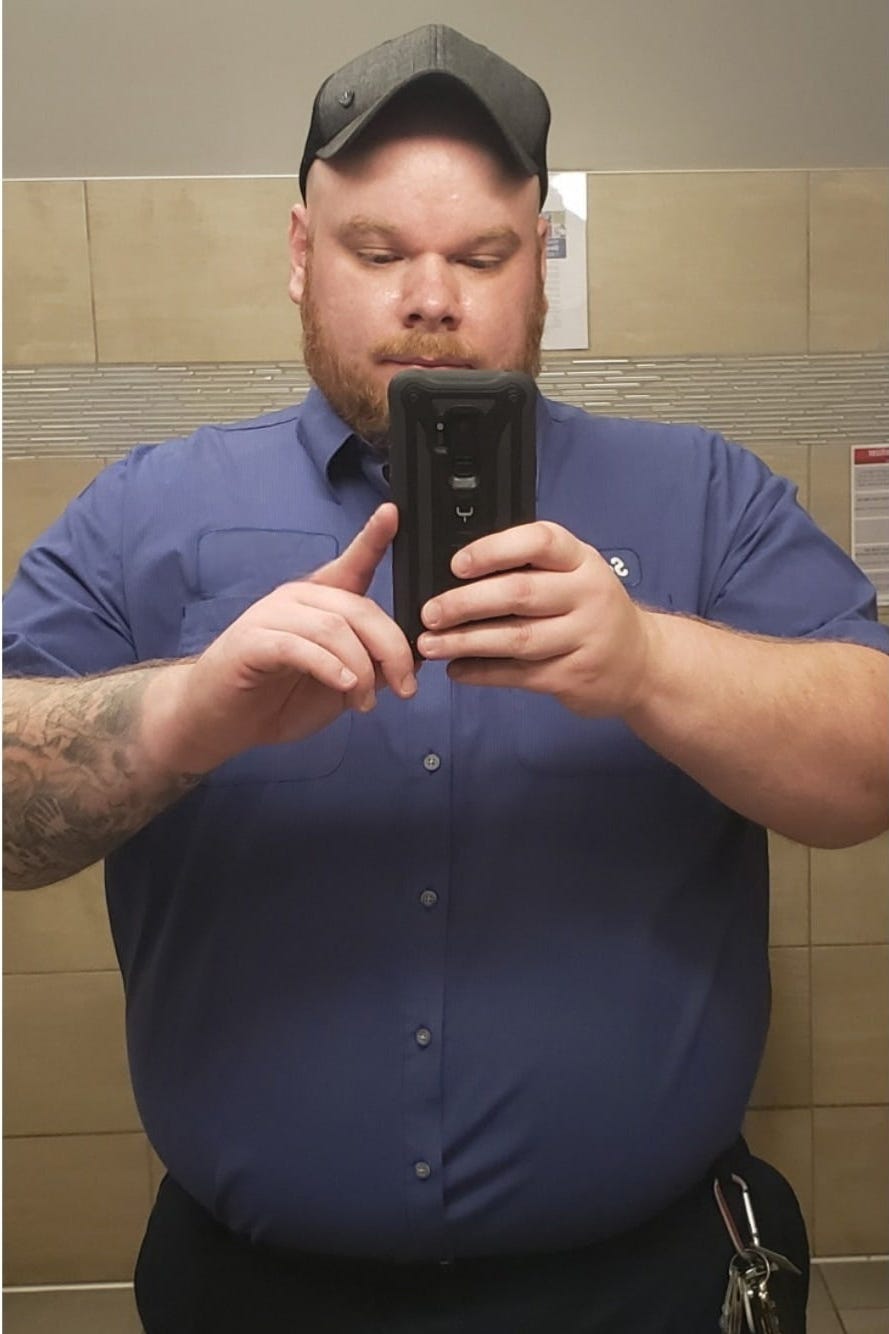 Rob Enderle
Rob Enderle
Rob in April 2024 before taking compounded semaglutide.
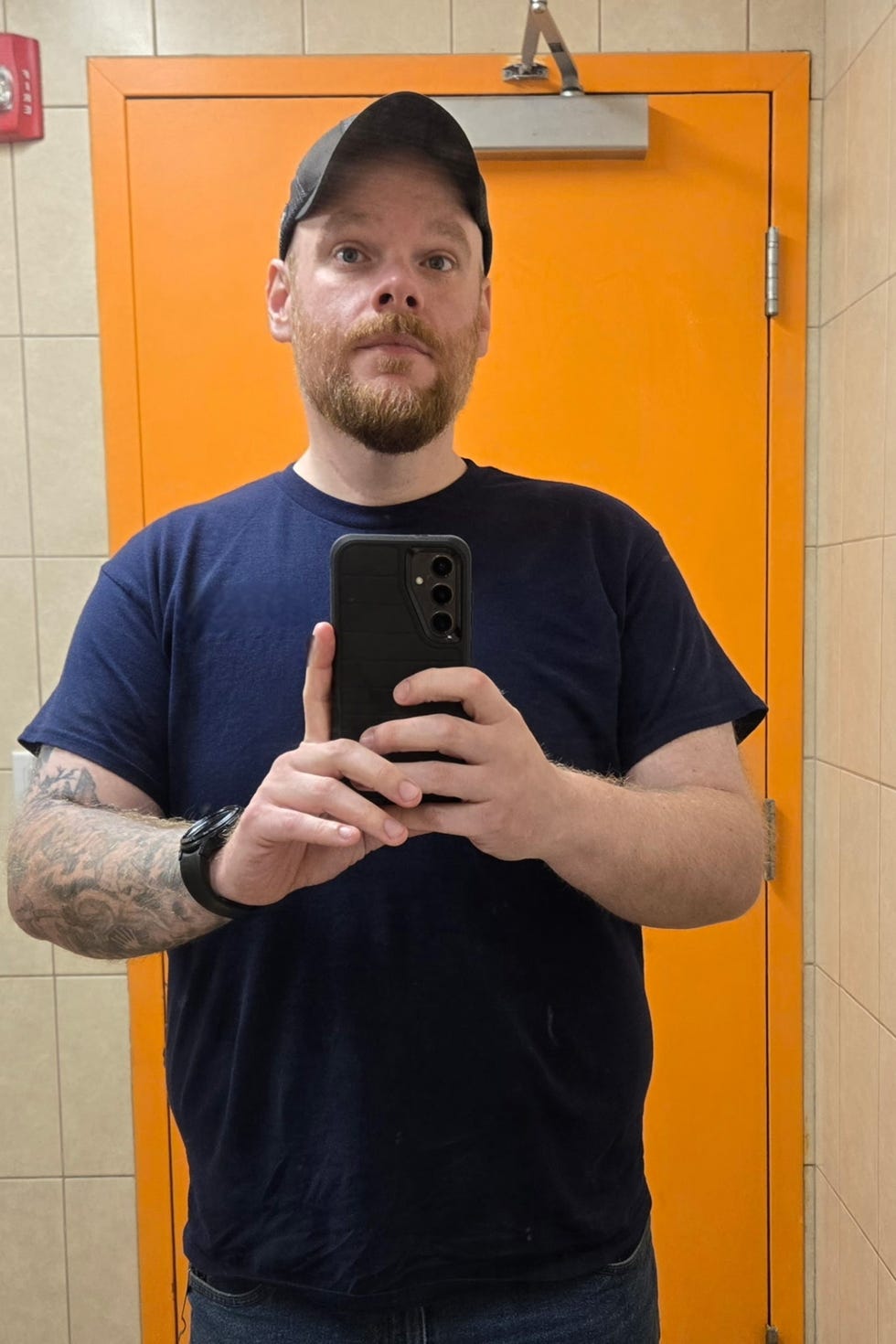 Rob Enderle
Rob Enderle
Rob a little over a year later in June 2025.
Some patients losing access to their compounded medications are considering switching over to generic liraglutide, an older GLP-1 medication that’s known to be less effective than semaglutide or tirzepatide. Others are looking into sourcing the medication from overseas, where safety standards could vary. And there are some people desperate enough to purchase ingredients from sketchy peptide sites sold “for research” and mix them on their own, which Dr. Ghosh says could be harmful.
The compounding pharmacies that supply telehealth companies aren’t giving up on this lucrative revenue stream without a fight. The Outsourcing Facilities Association (OFA), an industry group, sued the FDA last fall, saying its decision to take tirzepatide off the shortage list overreached its authority. A judge denied OFA’s motion for a preliminary injunction against the FDA, meaning that the FDA could continue to enforce this change as the case progressed.
There might be some loopholes in the meantime, though. Hims told its customers, including Rob, who are taking “personalized doses” of compounded semaglutide—incremental dosage amounts of the drug not commercially available for Ozempic or Wegovy—that they would be able to continue accessing compounded semaglutide for now. (A Hims & Hers spokesperson confirmed to me that the company would continue to make personalized doses of compounded GLP-1 medications available to its customers when appropriate.) The telehealth company also asked customers to consider signing a petition to preserve access to compounded GLP-1 drugs.
Rob says his annual Hims subscription renewed in May. If things change and he loses access to his personalized doses, he’s planning to do the best he can with diet and exercise—including the four to five miles of walking he gets in daily with his delivery drop-offs—and see what happens. The name-brand meds are just too pricey for him. In the meantime, he’s been encouraging guys on social media who are losing access to their commercial doses to contact Hims about switching to personalized amounts.
What Comes Next
There’s a lot we still don’t know about what’s next for this marketplace—and to borrow a line from the Hims ad, there are aspects of the system that remain broken. We have no clue how economic factors like tariffs could affect supply chains and price hikes, even for U.S.-formulated drugs (though Eli Lilly has been bracing for new tariffs on pharmaceuticals). We don’t know how the legal battle between the FDA and the OFA will pan out. And if lots of people taking compounded medications lose access to them and try to switch over to name-brand drugs, the spike in demand for those could mean they go into shortage all over again.
What is clear is that the crackdown on compounding is a major win for the drug companies, and telemedicine services will need to play nice with them to keep their GLP-1 supply flowing. Ro and Noom have already started partnering with them. At Ro, you can get a vial of Zepbound via Eli Lilly’s own telehealth platform, LillyDirect. And Noom has an agreement with LillyDirect’s pharmacy provider, Gifthealth, to provide single-dose vials for Noom’s members with a prescription from their own physician.
Before the FDA changed its policy on compounded meds, Lilly had been exploring ways to bring down its prices for self-pay customers, making discounted vials of Zepbound available through LillyDirect. It lowered the price of a 2.5-milligram dose of Zepbound to $349 a month, and of a 5-milligram dose to $499 a month. And Novo Nordisk recently introduced a digital savings offer for Wegovy that lowered the out-of-pocket price for a one-month supply to $499.
That’s still pretty steep, though, and the FDA has warned that fake Ozempic is on the rise. Some websites and online forums are taking advantage of people’s desperation and selling counterfeit medication at cheaper prices. The agency has seized packages of misbranded medication on multiple occasions over the past couple of years and even indicted the people behind the illegal transactions. Buying the drugs from an unlicensed seller—like someone offering medication through Facebook or Reddit—is incredibly risky. There have been cases where customers have received insulin instead of their expected weight-loss drugs from these types of shady sellers.
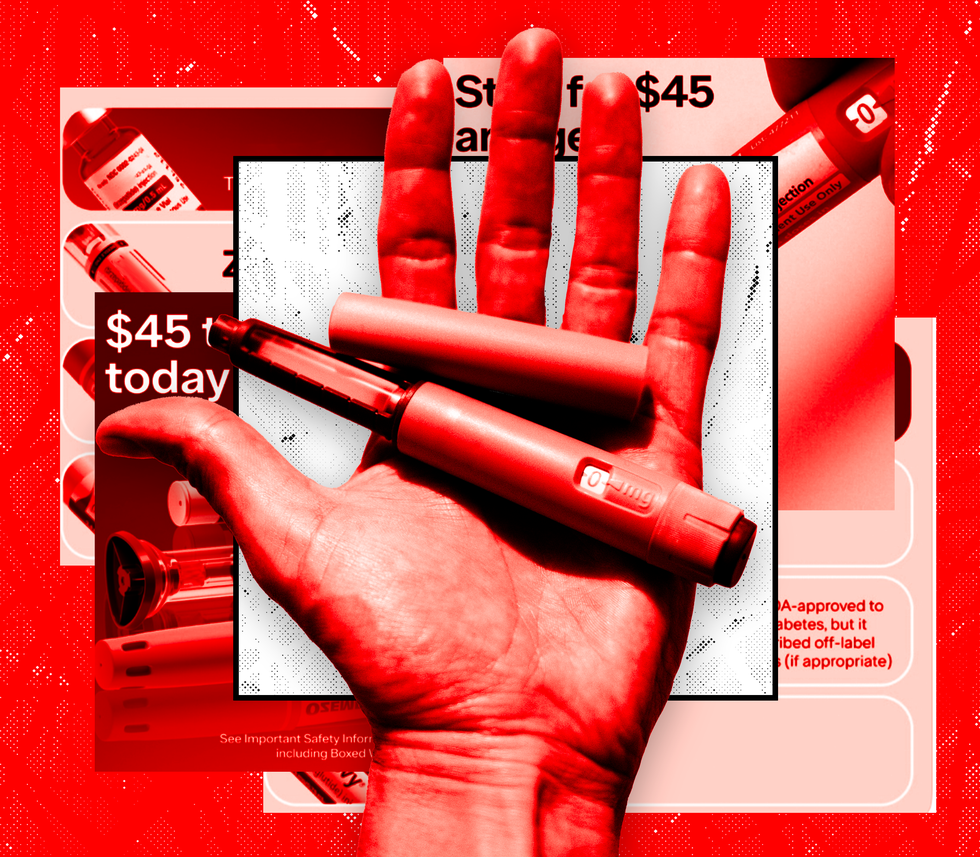
Getty Images. Men’s Health Illustration / Jason Speakman
Even with the familiar telehealth companies out there, you should still proceed with caution. Many telehealth companies don’t proactively monitor their patients for side effects or to adjust their medication dosage. Make sure there’s a way to get a quick response from a licensed practitioner (ideally someone trained in obesity medicine) if you don’t feel well or have questions, like by messaging through a patient portal. And be honest about the health information you provide, like your weight or any underlying health conditions. Fudging these details could lead to wonky dosing and maybe some not-great stuff for your health.
If you’re receiving a personalized dose, you’re also going to want to find out where your telehealth company gets its compounded drugs from. Telehealth companies should make the source of their medication supply transparent, and if they don’t, that’s a red flag. Reputable companies will provide labeling information for each batch of medication, so if a problem with a certain batch is discovered, you’ll know whether your supply is safe to use. Ask before you sign up if your medication will come labeled with a “lot” number—which identifies the compounding pharmacy and batch it comes from—or a different document called a certificate of analysis. Hims, for example, includes a slip of paper in its medication shipments with these details. You can look up the lot number on its website.
And remember: Avoid any telehealth company falsely claiming that compounded drugs have been approved by the FDA. Eli Lilly has already sued four telehealth companies, including Fella Health and Henry Meds, for allegedly selling knockoff tirzepatide without evidence of safety or effectiveness after the FDA ruled that they had to stop. Meanwhile, Novo Nordisk, who teamed up with Hims & Hers to provide direct access to Wegovy, ended its partnership with the telehealth company after one month because Hims & Hers continues to provide those personalized doses to customers. Novo Nordisk claims the telehealth company uses “deceptive marketing that puts patient safety at risk.”
In response to the claims, a Hims & Hers spokesperson told me: “We follow all applicable laws and regulations when it comes to advertising access to treatments via a telehealth platform. In addition, we clearly communicate to consumers that compounded products are not FDA-approved and come with risks. Transparency is core to how we operate.”
“Avoid any telehealth company falsely claiming that compounded drugs have been approved by the FDA.”
Dr. Ghosh anticipates that the pharma companies and their stacked legal teams, rather than the FDA, will end up driving how long those personalized doses can remain available. “In the next year, there’s probably going to be this back-and-forth dance that’s happening between the pharmaceutical companies and the compounding pharmacies, where the compounding pharmacies continue to make adjustments and look for loopholes, and then the pharmaceutical companies try to change the policies to close loopholes,” she explains. “I would guess eventually the compounds [including the personalized doses] won’t be available. We just don’t know what that timeline looks like.”
She went on to say that during the period when this is all hashed out, other medications will likely be introduced that could upend everything…again. On April 17, Eli Lilly announced that its drug orforglipron became the first oral GLP-1 to successfully complete a Phase 3 trial for safety and efficacy for people with diabetes and obesity. There’s an existing semaglutide oral tablet available from Novo Nordisk sold under the brand name Rybelsus, but Dr. Ghosh says the injectable GLP-1s out there remain far superior for blood sugar control and weight loss because of the way they’re metabolized. This new oral medication from Eli Lilly, which also comes with no food or drink restrictions, could change that.
That’s a good thing—because despite all the changes in this landscape, the demand for effective, affordable medications that help with weight loss and improve overall health isn’t going anywhere.
Related Stories
Lindsay Gellman is a writer in New York whose work focuses on the business of health. Her writing has appeared in The Wall Street Journal, where she was a staff reporter, as well as in The New York Times, The New Yorker, Wired, Businessweek, and elsewhere. She teaches in New York University’s graduate journalism program.
